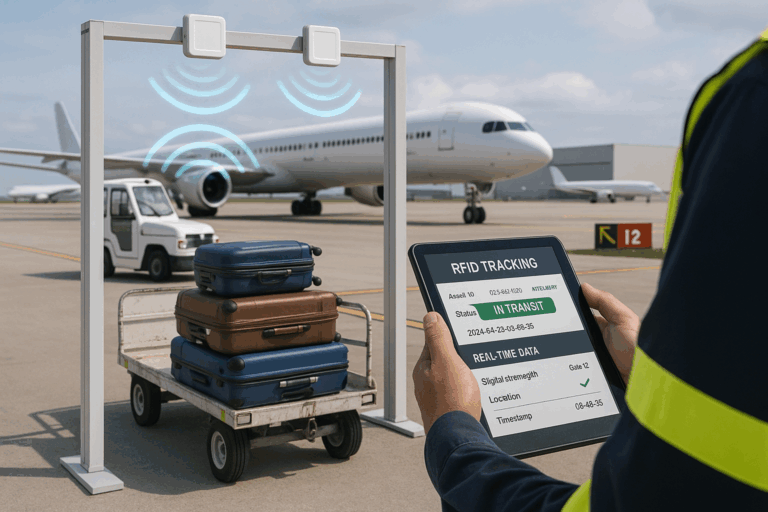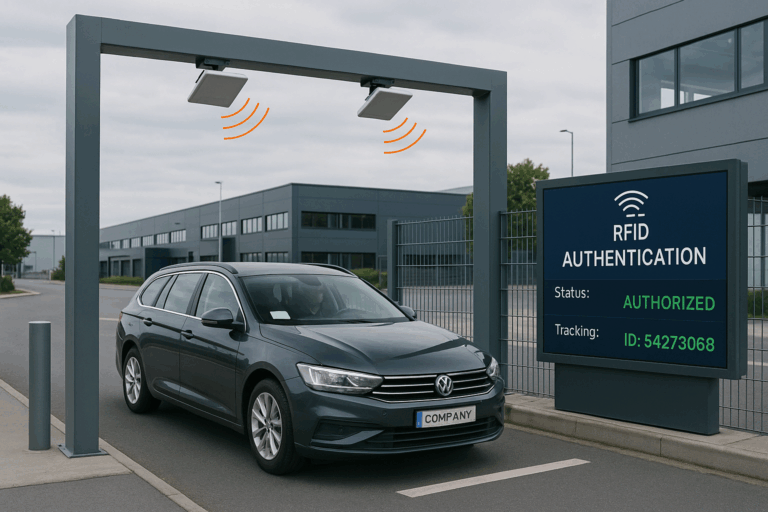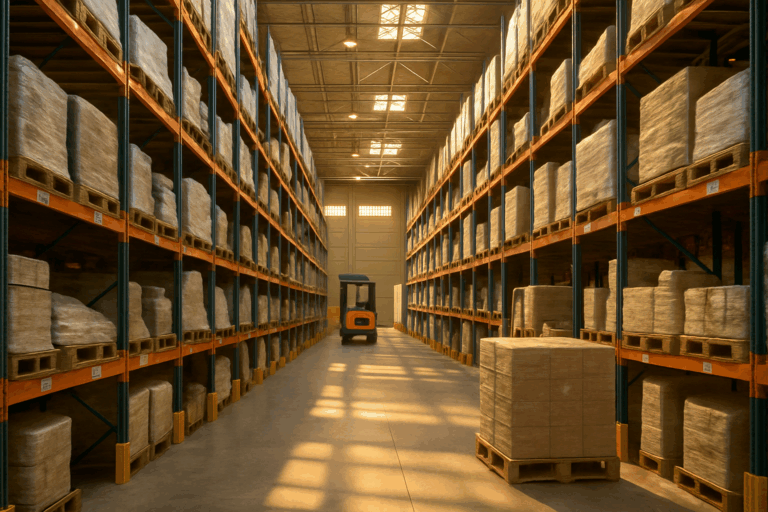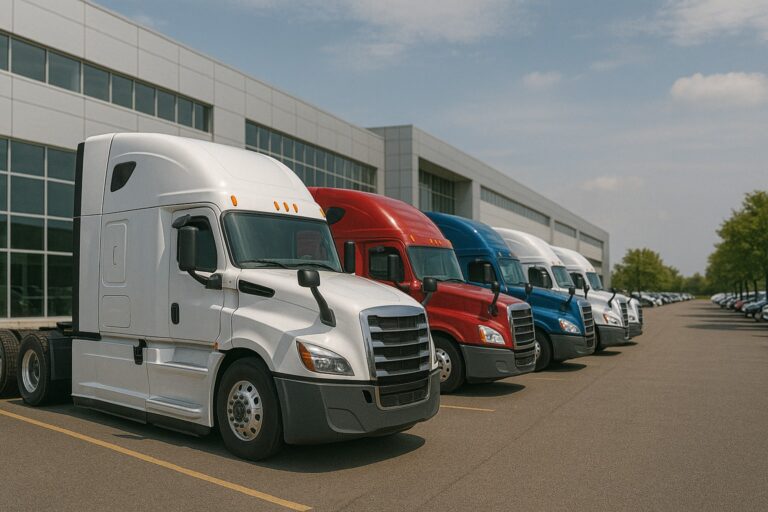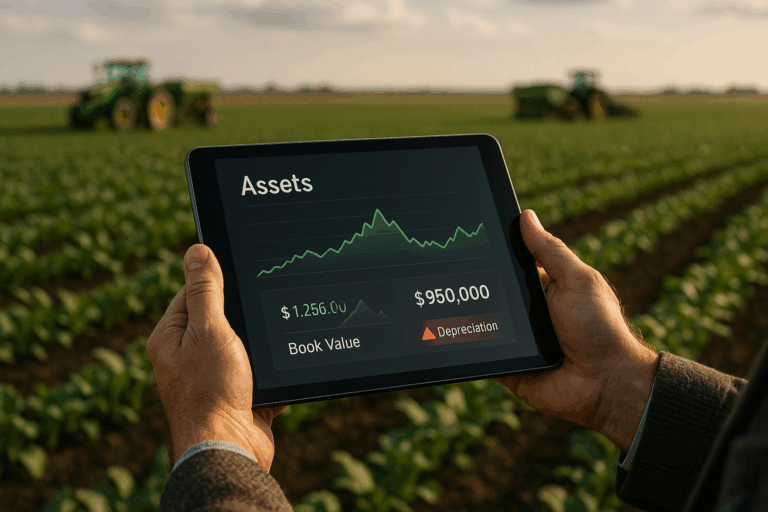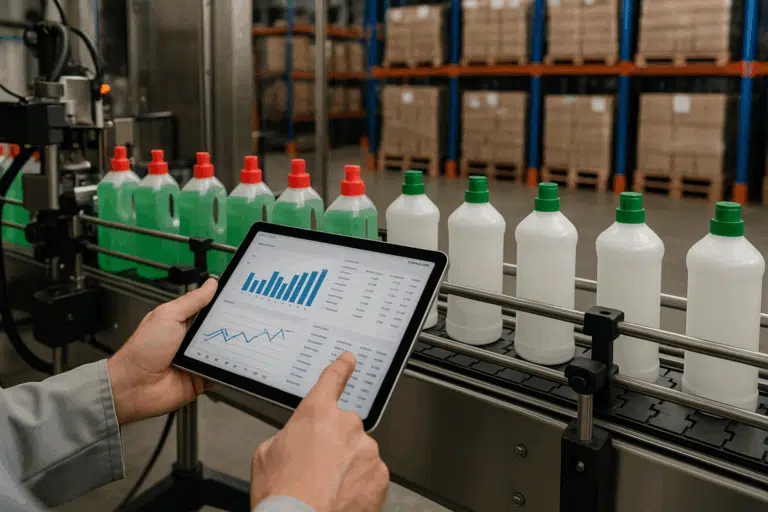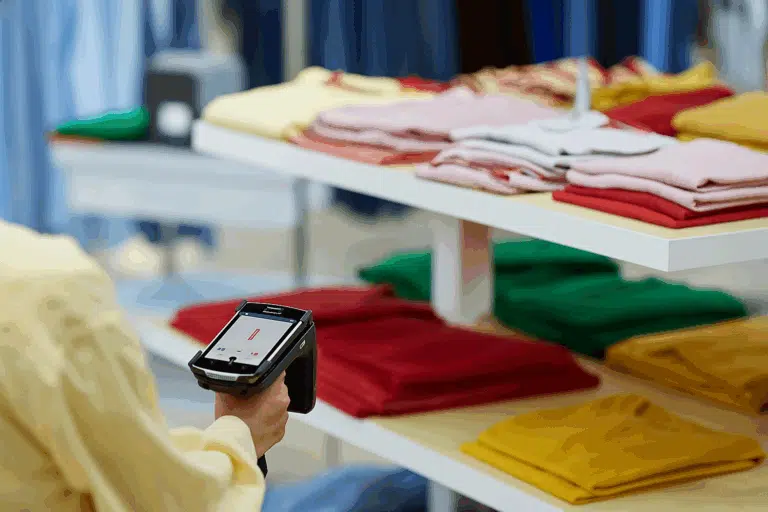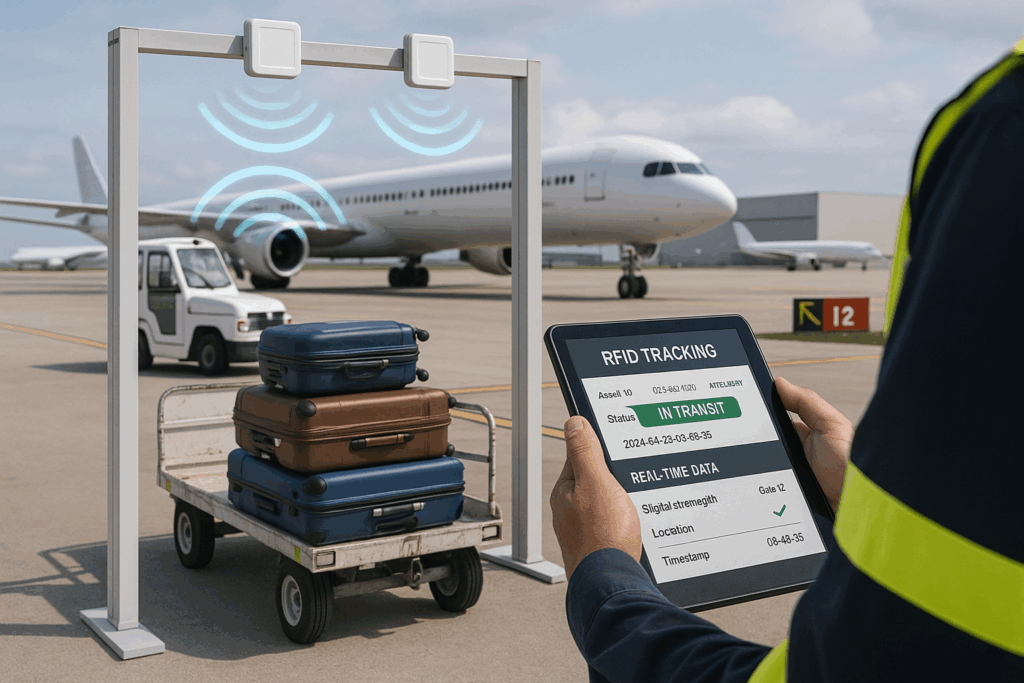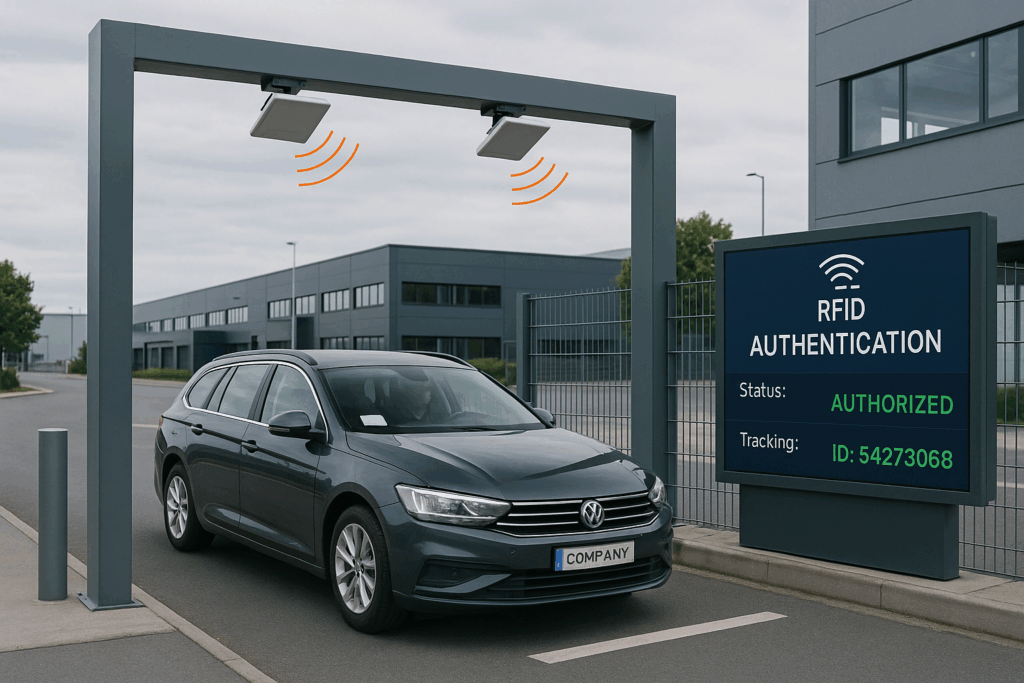Picture this: counting millions of items every year. One technology makes this much easier, the other doesn’t. The cost of RFID tags vs barcodes is key for businesses worldwide. The CPCON Group improves inventory control with cutting-edge RFID. Our technology can increase inventory accuracy from 65% to 99%.
Looking at the comparison of rfid and barcode pricing, costs and abilities are very different. Passive RFID tags start at $0.10, going up to $100 for active ones. Barcodes are cheaper, costing $0.01 to $0.05. But, checking the rfid vs barcode cost analysis needs looking beyond the start cost.

In a complex cost of rfid logs vs barcode review, think about more than price tags. Consider software, hardware, and how they work in different places. For example, a store counting 10,000 items weekly at $10 an hour costs $150.40 with barcodes. For the same job, RFID drops this to $6.67. For 500 stores, this saves millions in labor costs alone.
Table of Contents
ToggleKey Takeaways
- Knowing the cost of RFID tags vs barcodes is critical for efficient business choices.
- RFID costs more at first but saves money and improves management over time.
- Barcodes are cheap to start with, but they can cost more in the long run because they are slower and can have mistakes.
- RFID and barcodes have different uses, affecting how businesses handle their inventory.
- RFID boosts automation and security, which can outweigh the higher starting price in complex operations.
- Doing a thorough rfid vs barcode cost analysis includes looking at software, scanners, and big purchase savings.
- RFID or barcodes can work, depending on the type of business and what they need in terms of inventory tracking.
To learn more about the cost of RFID tags vs barcodes and find the best solution for your business, talk to our experts at The CPCON Group.
Understanding the Basics of RFID and Barcode Technologies

At CPCON Group, we focus on aiding businesses with their tracking needs. We cover the basics of RFID and barcodes. This will show you how they boost the efficiency of supply chain management.
What Are RFID Tags and How Do They Work?
RFID tags are key in tracking and managing inventory. They use a chip and antenna to send info through radio waves. Unlike barcodes, RFID can scan many items at once without being seen.
This fast scanning makes it perfect for big warehouses. Even though it costs more, it can save you a lot of time and effort. This is something to consider in a detailed rfid barcode cost comparison.
The Role of Barcodes in Inventory Management
Barcodes are a simpler, cheaper way to track items. They turn data into patterns that can be printed on labels. When scanned, these patterns become digital information.
Since they are low-cost and easy to use, barcodes are common in many places. They’re great for tracking items you can see without needing to scan many at once. This means they cost less than RFID systems.
RFID vs Barcode: The Technology Behind Data Capture
Choosing between RFID and barcodes depends on your business’s needs. RFID is best for quick scans of lots of items, like in big stores or warehouses. This can make inventory checks much faster.
Barcodes, however, shine in straightforward, point-of-sale scans. Because they’re direct and reliable, they’re great for many stores. Each has its own advantages for different situations.
Looking deeper into it, a mix of both RFID and barcodes might sometimes be the best choice. This can balance cost and efficiency well through the supply chain.
If you’re wondering how these techs fit your business’s budget, get in touch. Talk to one of our experts at CPCON Group. With lots of experience in this field, we’re ready to assist with your tracking and inventory needs.
Initial Investment: Assessing the Set-Up Costs
Businesses considering new tracking systems face various costs. The type of technology you choose shapes these expenses. We’re focusing today on RFID and barcode systems, looking at rfld price vs barcode price and barcode vs rfid cost effectiveness.
The Price of Implementing RFID Systems
RFID systems require a larger initial investment. They are known for their advanced tracking. The costs include tags, readers, and integrating the whole system.
Key components, like fixed UHF readers, can cost around $2,000 each. Mobile versions might go over $3,500. Passive RFID labels vary in price, from just a few cents to several dollars each. Setting them up also includes expenses for installation, integration with software, and labor, which can add up to over $7,500.
For big companies that can use RFID’s advanced tracking, these costs might be worth it. The rfid tag cost comparison is essential for big companies looking to maximize efficiency with RFID technology.
Costs Associated with Barcode Implementation
Barcodes, on the other hand, are very affordable and easy to use. Each barcode label costs only a few cents, which makes it a budget-friendly choice for many businesses. The upfront setup cost is minimal, requiring only basic printing and scanning equipment.
Barcodes are simpler to setup and use. They need less training and have no complex integration. This shows how barcode vs rfid cost effectiveness makes barcodes preferable for many.
At The CPCON Group, we see barcodes as a great, low-cost choice for many businesses. But, those needing extensive tracking or flexible data handling could find RFID more suitable. It might be worth the higher cost in these cases.
Truly understanding the Cost of RFID Tags vs Barcodes means looking beyond just the cost. Consider your needs and future goals. If you’re unsure about which system would fit your tracking or management needs, contact our experts. We offer advice based on our deep experience and cutting-edge knowledge. 🔔📚
Operational Costs of RFID and Barcode Systems
We’re looking at the costs of both RFID and barcode tech. This is key for companies wanting to get the most from their assets without spending too much. At The CPCON Group, we’ve learned that knowing about the usual and extra costs helps a lot when you’re choosing.
Understanding Recurring Costs for RFID Tags
RFID tags need to be replaced and the system maintained regularly. This makes using RFID a bit pricier. You have to update the software, fix the system, and sometimes change the hardware.
When we plan, the price of rfid tags is a big deal. RFID tags can last up to 10 years. Even though they cost more at first, not having to replace them often can save money for a smart business.
Maintenance and Replacement Costs for Barcodes
Barcodes are simpler and cheaper to keep up. Making new barcodes and changing them is easy, making them budget-friendly. But, they can get damaged by things like water or too much sun. So, you might have to replace them more often in some situations.
Here’s how the costs of RFID and barcodes stack up:
| Cost Factor | RFID System | Barcode System |
|---|---|---|
| Initial Setup Cost | Higher due to advanced equipment | Lower, simple scanners and printers |
| Maintenance Cost | Periodic software updates, hardware maintenance | Minimal; primarily replacement of labels |
| Replacement Cost | Lower frequency but higher cost per tag | Higher frequency but low cost per label |
| Operational Flexibility | High, with ability to read through materials | Limited, requires direct line of sight |
Comparing RFID tags to barcodes, both have good and bad points. At The CPCON Group, we can help you figure out what tech fits your needs best. With our experience, we’ll give you the advice you need.
Let’s talk about how we can make your inventory and asset tracking better. We aim for systems that save you money and work well for your business.
Cost of RFID Tags vs Barcodes: Comparing Tag and Label Expenses
Many clients at The CPCON Group are comparing RFID with barcodes. The analysis shows RFID tags have higher upfront costs than barcodes, but their benefits over time are great. Businesses need to look closely at the costs of both to see which fits their goals best.
Passive RFID tags are more common and cost about 11 cents each. On the other hand, barcode labels are much cheaper, usually under a penny. This big cost difference makes barcodes better for tracking many items. They are best for places not needing to track each item closely.
| Technology Type | Average Cost per Unit | Common Applications |
|---|---|---|
| Passive RFID Tags | $0.11 | Inventory tracking, asset management |
| Barcode Labels | $0.01 | Point of sale, inventory labeling |
RFID is key for more accurate inventory. Spending $2.5 million on RFID tech each year can boost accuracy from 65% to 99%. This big jump cuts costs related to lost or untracked items, a big issue with barcodes.
RFID allows for better automation and more useful data gathering. This helps with planning and quick decision making. Barcodes, however, are not as dynamic and can’t track items in real time.
Choosing between RFID and barcodes should be based on what your business needs. It depends on the amount of inventory and how closely you need to track it.

In the end, investing in RFID may be costly at first, but it offers great savings and benefits later on. For businesses with less money or simpler tracking needs, barcodes are a good choice. Contact us at The CPCON Group to find out more. We can help you figure out the best option for managing your assets.
The Impact of Volume on Cost Efficiency
At CPCON Group, our work in fixed asset management and inventory control shows how volume affects cost. Compare rfid vs barcode costs with us. It’s key to see how buying in bulk can change which technology is best for you.
Scaling RFID Operations: How Bulk Purchases Affect Cost
RFID systems become more cost-effective in large amounts. Buying RFID tags in bulk lowers the cost of each tag. This upfront cost may be higher than barcodes, but overall costs go down, especially for big operations. This efficiency suits businesses with a lot of inventory or those needing to track items across large spaces.
Barcode Cost Advantages at Larger Quantities
Barcodes excel at keeping costs down as you grow. The price per barcode label drops a lot when you buy in bulk. This cost-saving feature makes barcodes great for simple tracking needs without the high initial costs of RFID systems.
Deciding between RFID and barcodes involves looking at expected volume and tracking needs. Let’s compare them at different scales:
| Volume | RFID Cost Per Unit | Barcode Cost Per Unit | Cost Efficiency at Scale |
|---|---|---|---|
| 1-100 units | $2.50 | $0.10 | Barcode |
| 101-10,000 units | $1.90 | $0.05 | Barcode |
| 10,001+ units | $0.80 | $0.03 | RFID |
In conclusion, when choosing between RFID and barcodes, think about business size and tracking needs, not just the cost of RFID tags vs barcodes.For help deciding, reach out to CPCON Group. We can help you make the best choice for your needs and budget.
Analyzing the Impact of Error Rates on Overall Costs
We at CPCON Group know errors cost more than just accuracy. They hurt finances and cost benefits. The gap between RFID and barcode accuracy affects the rfid tag cost benefits, cost of RFID tags vs barcodes, and rfid vs barcode cost effectiveness. Let’s see how RFID’s higher accuracy saves money and why fixing barcode errors matters.
How RFID Accuracy Saves Money Long-Term
RFID’s exact tracking can save lots for companies. A study in 2010 proved RFID can identify people and vital data in 81 medical cases. A hospital in North Carolina used RFID to watch newborns, quickly alerting staff when a baby was taken, saving a big crisis. These show the long-term money RFID saves.

Also, RFID reduces work needed, cutting labor costs in distribution centers, which can be a big part of expenses. It makes things faster and cuts the need for manual scans that barcodes use.
The True Cost of Barcode Scanning Errors
Although barcodes are cheap, they can cause big problems. Errors with barcodes lead to wrong counts and need time and resources to fix. This can slow down business and raise costs. It’s why companies should think about the comparison of rfid and barcode pricing carefully.
To get your business in better shape, use the latest tracking tech. Contact us to learn more about RFID’s benefits and how it fits your needs.
Comparing Reading Speeds and Labor Costs
At The CPCON Group, we see how RFID technology boosts work efficiency. This is especially true when looking at the costs of rfid vs barcode cost comparison. It’s key to note the big differences in how quickly RFID and barcodes read, and their labor costs. This is important for companies checking their inventory management options.
RFID tech lets you scan many tags all at once, speeding up data collection a lot. A single RFID scanner can check 18,000 tags in an hour. But, barcode scanning by hand is much slower. An employee can only get through about 650 barcodes in the same time. This means using RFID can save a lot on labor and costs, making barcode vs rfid cost effectiveness very important to think about.
- Initial Investment: Setting up RFID can cost more at first, according to comparison of rfid and barcode pricing. But, it saves a lot in labor costs. These savings can be as high as 50%.
- Monthly Operating Costs: After the start-up, RFID systems keep saving money monthly. This can add up to big savings, like 5,454 euros ($6,059) a month for the workforce. There are also savings in lost products and penalty costs, adding up to 15,625 euros ($17,357).
- Accuracy and Reliability: RFIDs are more accurate, making tracking and managing inventory better. This can save as much as 187,500 euros ($208,289) a year by cutting down on lost products.
So, even though RFID’s beginning cost is high, its faster work and less labor make it a clear pick for places needing accurate, quick inventory handling. It’s a good idea for companies to carefully consider these points to choose what’s best for their needs and budget. If you’re interested in how RFID can change your inventory process, reach out to our experts today.
The Influence of Material Types on Cost and Performance
In inventory management, how material and technology work together has a big impact on cost and results. We need to know how different stuff affects RFID tags and barcodes. This helps businesses pick the best tech. At The CPCON Group, we see how materials change our tracking methods’ efficiency and barcode cost efficiency.
Materials Impacting RFID Tag Functionality and Cost
While RFID technology stores and gets data well, it has trouble with metals and liquids. These materials break RFID signals. So, special RFID tags are needed for these cases, affecting the rfid tag cost comparison. For instance, RFID tags for use on metals need an insulating layer to keep the signal strong. This makes them more costly. But, in places where metals or liquids are common, these tags are the best choice.
Barcode Performance Across Different Substrates
Barcodes, on the other hand, do well with various materials. They work on paper, plastic, or glass with no problems. This makes them cost-effective and suitable for many products. But, barcodes need a direct scan and can get damaged. This might mean extra costs for replacing or rescanning.
Picking the right tech for your needs is crucial. For a detailed ‘rfid vs barcode cost analysis’, companies must look at their full setup. At The CPCON Group, we guide companies to select the best and most affordable tech for their operations.
In summary, RFID is strong in handling lots of data and survives well, but barcodes are flexible and cost less. If you’re deciding between the Cost of RFID Tags vs Barcodes and their effectiveness, our experts can help. Contact us to make your inventory management better.
Long-Term ROI: RFID Tag Cost Benefits vs Barcode Efficiency
Discussing rfid vs barcode cost comparison, we look at the long-term return on investment (ROI) each offers. The CPCON Group has deep knowledge in this area. We see clear financial differences when choosing between RFID and barcodes for inventory management.
Evaluating Long-Term Savings with RFID
RFID, despite its higher start-up cost, offers significant long-term savings. This is especially true for complex operations needing detailed tracking and quick data access. RFID can boost inventory accuracy by up to 13% and handle multiple tags at once. This cuts down on labor costs, which are usually the biggest spend in a warehouse.
RFID tags also last longer and work well in various environments. This means fewer replacements and less maintenance. These factors all add to the long-term cost-saving benefits of RFID technology.
The Benefits of Barcodes for Budget-Conscious Operations
Barcodes are best for smaller or simpler inventory needs due to their low initial and running costs. They’re easy to use and require little training. This simplicity means quick implementation and immediate savings. In retail and distribution, customers benefit from barcodes too. Scanning is faster than entering data by hand, which improves the shopping experience.
Choosing between RFID and barcodes depends on a business’s specific requirements. RFID suits those aiming for long-term efficiency and growth, thanks to its advanced features. On the other hand, barcodes are great for quick, affordable solutions that still deliver.
Both RFID and barcodes have pros and cons depending on your business’s size and goals. At The CPCON Group, we use our 25 years of experience to help align technology with your strategy. Get in touch for advice on how RFID or barcode solutions can enhance your inventory management and boost your profits.
Conclusion
In the changing world of keeping track of stuff, it’s key to know the difference between RFID tags and barcodes. Sure, RFID tags cost more by themselves than barcodes do. But the benefits like better accuracy and faster tracking can’t be ignored. We’ve found that using RFID can save a lot of time, up to 15 times, and makes almost no mistakes in keeping track of items.
Choosing between RFID and barcodes depends on more than just the initial cost. We look at what your business really needs, like how much stuff you have or the challenges of your work environment. For many, barcodes are a cheap and easy choice, especially because they helped with the big increase in global trade over the past ten years. But, RFID is best if you have a lot of different things to track or if you work in a hard-to-reach place.
If you’re not sure what’s best for your business, The CPCON Group can help. We offer advice on choosing between RFID and barcodes that takes into account your budget now and your future needs. Let us know you’re interested, and we’ll find the best way to improve how you manage your inventory. It’s all about taking your business to the next level and being more efficient in the long run.
FAQ
What Are RFID Tags and How Do They Work?
RFID tags move information using radio waves to a reader. This happens for easy ID and tracking of items. Some tags get energy from the reader’s magnetic field. Others have their power source and can be read from farther away.
The Role of Barcodes in Inventory Management?
Barcodes are a simple, cheap way to track products. They hold information in a pattern a machine can read. This makes organizing and buying stuff faster and easier.
RFID vs Barcode: The Technology Behind Data Capture?
RFID can read many tags at once, even without being seen. Barcodes need to be scanned one by one. RFIDs can gather more data, but barcodes work well almost everywhere and are easy to use.
What The Price of Implementing RFID Systems?
Putting in RFID needs a big first outlay for equipment. You need printers, readers, antennas, and software.
What the Costs Associated with Barcode Implementation?
Barcodes are cheaper to start because you don’t need much special equipment. Printers make the labels, and scanners read them. Software for barcodes is also simpler and costs less.
Understanding Recurring Costs for RFID Tags?
After starting, RFID costs include replacing tags and keeping equipment working. Tags may cost more than barcodes, but using them saves time. This can make them cheaper in the long run.
Maintenance and Replacement Costs for Barcodes?
Barcodes are less costly to keep up because they don’t need special care. Training to use them is simple. And there are many affordable scanners and printers.
Cost of RFID Tags vs Barcodes: Comparing Tag and Label Expenses?
RFID tags are usually more expensive than barcodes. But, for the best choice, you have to look at what you need them for. Costs and value change depending on use.
Scaling RFID Operations: How Bulk Purchases Affect Cost?
Buying RFID tags in large amounts makes them cheaper. This can make RFID a better cost choice for businesses needing lots of tags.
Barcode Cost Advantages at Larger Quantities?
Barcodes stay cheaper as you get more. This is good for businesses that use a lot of them. Costs drop when you buy barcodes in bulk.
How RFID Accuracy Saves Money Long-Term?
RFID is very good at not making mistakes. This keeps costs low by avoiding overstock and lost sales. It’s a smart long-term investment because it makes sure products are available when people want to buy them.
The True Cost of Barcode Scanning Errors?
Barcode mistakes can mess up how you manage stock. This can waste money by needing to reorder too much or not finding the things you need. These errors can make running a business more expensive and less efficient.
The Influence of Material Types on Cost and Performance?
RFID can be more expensive for items like metal or liquids. Barcodes work well on many materials, which doesn’t raise their cost. So for some special types of things, RFID’s cost goes up.
Evaluating Long-Term Savings with RFID?
RFID can cost more at first but saves money over time. It does this by lowering labor, cutting mistakes, and tracking inventory well. In fast-moving or complex settings, it can bring big savings and benefits.
The Benefits of Barcodes for Budget-Conscious Operations?
Barcodes are great if you’re starting small or on a tight budget. They’re easy to use and save money right away. This makes them a popular choice for many businesses.



